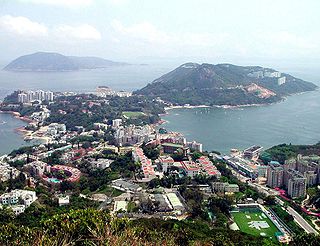
Stanley, or Chek Chue, is a coastal town and a popular tourist attraction in Hong Kong. It is located on a peninsula on Hong Kong Island. It is east of Repulse Bay and west of Shek O, adjacent to Chung Hom Kok and Tai Tam. Administratively, it is part of the Southern District.
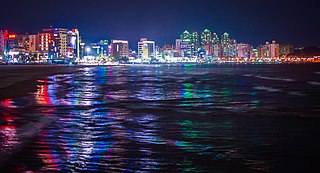
Pohang, formerly spelled Po-Hang, is the largest city in North Gyeongsang Province, South Korea, with a population of 499,363 as of 2022, bordering the East Sea to the east, Yeongcheon to the west, Gyeongju to the south, and Cheongsong and Yeongdeok to the north.

Muan County (Muan-gun) is a county in South Jeolla Province (Jeollanam-do), South Korea. In 2005, Muan County became the capital of Jeollanam-do following the transfer of the provincial office from its previous location, Gwangju to the village of Namak in Muan. Muan International Airport was opened here, and will eventually replace the airports in Gwangju and Mokpo.
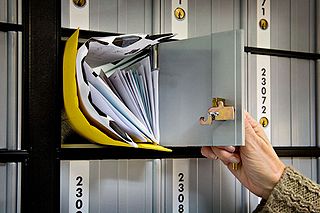
A post office box is a uniquely addressable lockable box located on the premises of a post office.
South Korea is made up of 22 first-tier administrative divisions: 6 metropolitan cities, 1 special city, 1 special self-governing city, and 14 provinces, including three special self-governing provinces and five claimed by the ROK government. These are further subdivided into a variety of smaller entities, including cities, counties, districts, towns, townships, neighborhoods and villages.

Cheonan is the largest and most densely populated city of Chungcheongnam-do, South Korea, and the third largest city in the Hoseo region after Daejeon and Cheongju. Cheonan borders Gyeonggi-do in the north, Chungcheongbuk-do to the east and southeast, Sejong City to the south and Asan-si and Gongju-si to the west and southwest.

Seosan is a city in South Chungcheong Province, South Korea, with a population of roughly 175,000 according to the 2017 census. Located at the northwestern end of South Chungcheong Province, it is bounded by Dangjin City, Naepo New Town, Yesan-gun and Hongseong-gun on the east, Taean-gun and the Yellow Sea on the west, 125 km (78 mi) south of Seoul, 159 km (99 mi) northwest of Daejeon and 34 km (21 mi) northwest of Naepo New Town. Seosan is the hub of transportation of the west coast where the Seohaean Expressway, Daejeon-Dangjin Expressway, National Highways No. 29, 32, 38 and 45 intersect.

Gimcheon is a city in North Gyeongsang Province, South Korea. It is situated on the major land transportation routes between Seoul and Busan, namely the Gyeongbu Expressway and Gyeongbu Line railway.

Gumi is the second largest and most densely populated city in North Gyeongsang Province, South Korea. It is located on the Nakdong River, halfway between Daegu and Gimcheon, also lies on the Gyeongbu Expressway and Gyeongbu Line railway which are the principal traffic routes of the country.

Mungyeong is a city in North Gyeongsang Province, South Korea. The local government, economy, and transportation networks are all centered in Jeomchon, the principal town. Mungyeong has a lengthy history, and is known today for its various historic and scenic tourist attractions. The city's name means roughly "hearing good news." Recently, development has been somewhat stagnant with the decline of the coal industry. Since the 1990s, the proportion of people who rely on the tourism industry through Mungyeong Saejae has gradually increased.

Cheongdo County (Cheongdo-gun) is a county in North Gyeongsang Province, South Korea. It is connected to the national transportation grid by the Gyeongbu Line railroad and the Daegu-Busan Expressway. The seat of government is located in the center of the county, in Hwayang-eup.
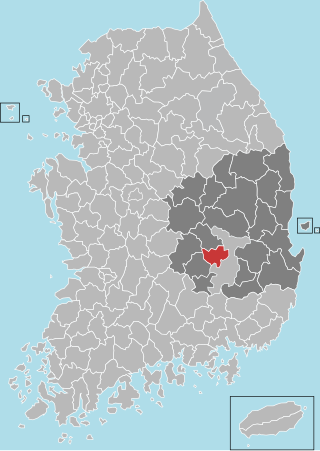
Chilgok County (Chilgok-gun) is located at south-west part of North Gyeongsang Province. It is close by Gunwi County on the east while adjoins with Gimchon-si, Seongju County on the west. It is also a transportation hub where the Nakdong river flows through and an Urban-Farming complex that adjoins with Gumi City and Daegu Metropolitan city.
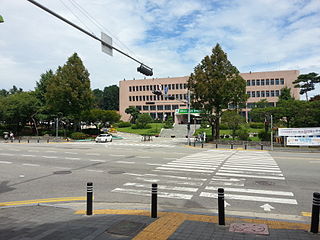
Songtan is an area in the northern end of Pyeongtaek, Gyeonggido, South Korea. Songtan achieved city status in its own right in 1981, five years earlier than Pyeongtaek, but merged, along with Pyeongtaek County, into Pyeongtaek City in May 1995.
The primary subdivisions of Gyeongju in South Korea consist of 4 eup, 8 myeon, and 11 dong. These units are the same into which all of the cities and counties of South Korea are divided. The dong units occupy the area of the city center, which was formerly occupied by Gyeongju-eup. Eup refers to a substantial village, whereas the myeon are more rural. The current divisions are as follows, using the numbers given on the map:
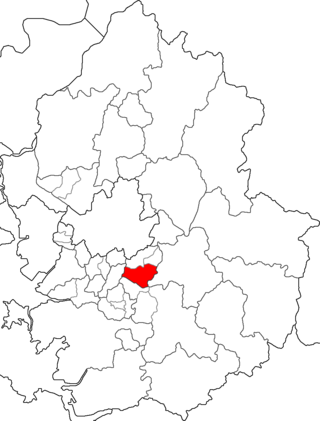
Bundang-gu (Korean: 분당구) is the largest and most populous district (gu) of Seongnam, a major city in the Seoul Capital Area, South Korea. Bundang-gu is one of South Korea's wealthiest and highest developed areas, being the nation's first and largest completely artificial city built in the early 1990s. Many high-rise luxury condos moved in the early 2000s, with a second planned city built in the late 2000s called Pangyo in the same district. Apartment prices are the second highest in Gyeonggi-do after Gwacheon and 7th highest nationwide, higher than many central Seoul districts such as Mapo-gu or Jongno-gu. Apartments around Pangyo station and the high-rise luxury condos around Jeongja station and Sunae station rival prices in the most expensive areas in the country. Unlike older cities such as Seoul, Bundang has no telephone poles overground, resulting in a clean cityscape with well-designed streets.

Express Bus Terminal Station is a station on the Seoul Subway Line 3, Line 7, and Line 9. The stations are located in the Greater Gangnam Area, Banpo-dong, Seocho District, Seoul, Korea.

Camp Carroll Army Base is located on the southeast portion of the peninsula of South Korea, in the village of Waegwan, approximately 20 km from the city of Daegu. Camp Carroll is bound by urban areas on the northwest, west, and southwest. Hilly forested areas bound the base on the north and east. Agricultural fields border the base on the northeast and to the south. The Nakdong River flows nearby, southwest of the base. Camp Carroll has been a supply staging ground for U.S. military operations on the peninsula and in the Far East since the late 1950s. Often referred to as "The Crown Jewel of Area 4", it is named after Sergeant First Class Charles F. Carroll, a posthumous recipient of the Distinguished Service Cross for his acts of heroism during the Korean War.

Joam is a small town located in Gyeonggi-do, South Korea. The town is a part of the primarily rural and agricultural city of Hwaseong. Joam is also the urban center of Ujeong-eup, the population of which is approximately 18,000 and which encompasses both Joam and much of the surrounding countryside. Agriculture is the primary use of land in the region, rice being the main crop but with Chinese cabbage, radish, chili peppers, other fruit and vegetables, and livestock being grown and raised. The area is also home to several industrial sites including a large Kia Motors test facility.

Seojeongni Station is a station in Seojeong-dong, Pyeongtaek, South Korea. Mugunghwa-ho trains running on the Gyeongbu Line stop here. Additionally, services on Seoul Subway Line 1 have been calling at this station since 2005. Its station subname is Kookje College.
Hadang (Korean: 하당신도시) is the newly built urban area in Mokpo, Jeollanam-do of South Korea, which aims at accommodating increased population near Muan International Airport and movement of the provincial office. Before announcement of the transfer of office, Mokpo city initially intended to rebuild another area for housing. The project was finalized so until 1999 most of area was leased for marketing, business, housing, and preliminary purpose.

















